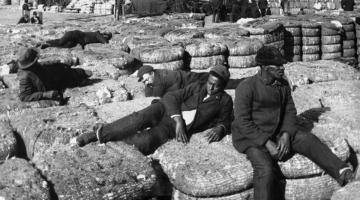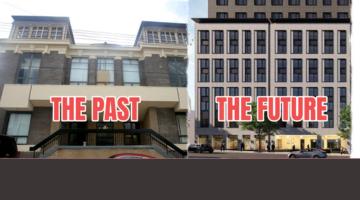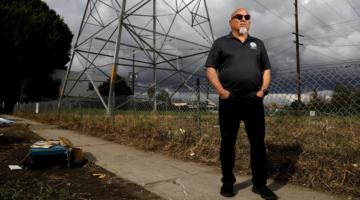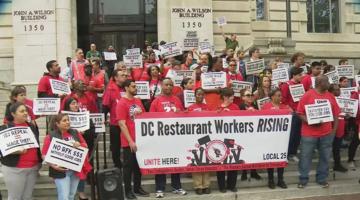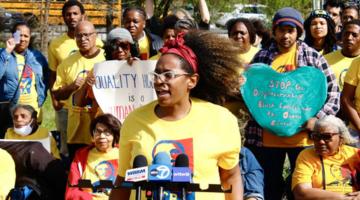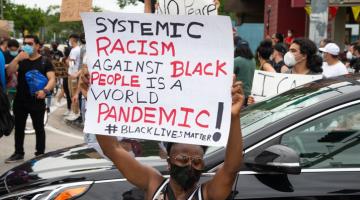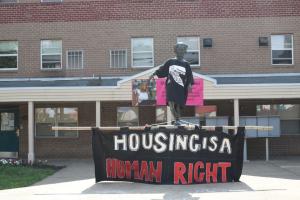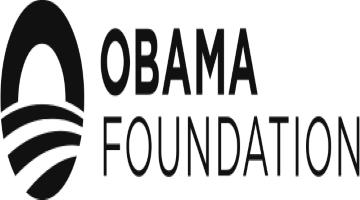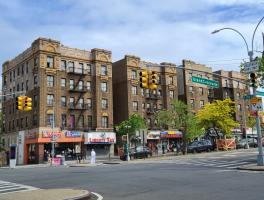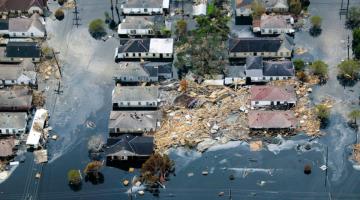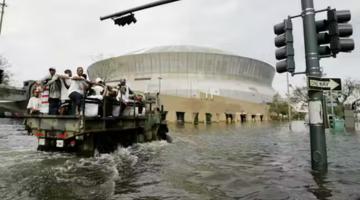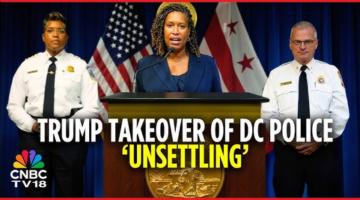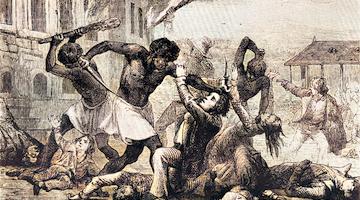Between 1968 and the end of the ‘70s, the Bronx was the scene of thousands of fires.
“The owners of the buildings were paying local gangs to set fire to buildings.”
It’s been some time since The Warriors portrayed the Bronx for the world as an infamous and dangerous neighborhood ruled by the petty criminal underworld. However, in the minds of many people, the Bronx is still thought of as the enormous ghetto just north of Manhattan island, one that has always been that way.
Of course, that view is mistaken. Ghettos are not born by accident, and the terrible conditions in which minorities live are the result of the frequent closeness between politics, real estate finance and powers-that-be both small and large. It’s an ancient story that keeps happening again and again. Nonetheless, thanks to a great mobilization and the public visibility of characters such as Alexandria Ocasio Cortez, Amazon was forced to give up the idea of building its second headquarters in Long Island City, a neighborhood in Queens which is already at an advanced stage of gentrification—a story to which we will return below.
“Ghettos are not born by accident.”
There was a time when the Bronx used to be the port of call for immigrants from all over the world who coexisted in relative harmony, with the idea that all of them were trying to live the American dream. Merchants and construction workers, restaurant owners and drivers, tailors and cooks—they were a budding middle class who brought their customs to New York and mixed them together with those of other newcomers. There was a lot of life in the streets. People knew each other, and they had high hopes. This is how Vivian Vázquez Irizarry tells the story of the neighborhood in her Decade of Fire, a documentary on the years of widespread fires between 1968 and the late ‘70s, co-directed with Gretchen Hildebran. Vazquez experienced that period herself as an inhabitant of the South Bronx.
The story of that tragic period begins with redlining and re-zoning, administrative decisions dictated both by real estate interests and by the political choice to separate and segregate. Starting from the ‘30s, it was decided to map out the city on the basis of the level of safety of real estate investments: marking an area in red on the city map meant abandoning it to its fate, if it was already experiencing degradation, or allowing it to fall into decay—which is what happened to the South Bronx. At the same time, re-zoning is the instrument through which the government of a city allows property developers to redevelop an area by changing the maximum allowed building height, the types of buildings allowed and their locations. Redlining results in depreciation and abandonment, while re-zoning results in a positive reevaluation.
“Marking an area in red on the city map meant abandoning it to its fate.”
As Richard Rothstein recounts in his The Color of Law, an account of the regulations that have caused urban segregation in US cities, the story of black neighborhoods is similar everywhere. In Baltimore, the anti-black regulations came as a reaction to the first home purchases by the black middle class in white neighborhoods in the early 20th century.
In the case of the Bronx, the “zoning” was occasioned by the construction of a road that divided the neighborhood in two. Segregation also came as a result of the incentives to move, in the form of public subsidies and generous loans, available only for whites—at the same time, blacks and Latinos could not get loans approved.
It was at this time, for instance, that a major proportion of Italian-Americans moved into single-family homes, which still remain the heart of non-metropolitan America. This is what happened to those who used to live in the South Bronx.
The area began to deteriorate, while the blacks pushed out from other areas of Manhattan were driven to move here. Then, the riots began. In 1968, these were taking place across the US. At the time, the commission convened by President Johnson to figure out what was going on concluded that the causes included the discriminatory provision of municipal services, discrimination in the administration of justice and housing discrimination.
“The story of black neighborhoods is similar everywhere.”
The then-Governor of Illinois, Otto Kerner, the head of the commission, wrote that the policies at the time were enshrining “the division of our country into two societies; one, largely Negro and poor, located in the central cities; the other, predominantly white and affluent, located in the suburbs and in outlying areas.” After 40 years, the situation has not changed much: the lower quality of schools and public services, the increased distance from the places where one can work and shop, and bad transportation are still making the life experience of blacks different from that of whites.
Decade of Fire tells this story as it happened in the New York of the ‘70s. Between 1968 and the end of the ‘70s, the Bronx was the scene of thousands of fires, a crisis that was ignored by the authorities and which led to the displacement or outright abandonment of 250,000 people. The archival images show entire blocks in flames, enormous open-air dumps and children playing on deserted streets, reminiscent of Berlin in 1945, or Sarajevo in 1996.
“For years, they said that we were at fault for those fires, but after doing archive research for this documentary, I discovered that the fault was not ours, and that instead, thanks to the community effort, we helped save our neighborhoods,” Irizarry said at the documentary’s premiere at the Metrograph Cinema in New York City, located in the gentrifying Lower East Side, where restaurants are charging $18 for spaghetti with tomato sauce.
“Archival images show entire blocks in flames, enormous open-air dumps and children playing on deserted streets.”
The fires started because of low-quality utility installations and gas stoves, combined with the lack of maintenance by unscrupulous landlords. Over time, they became a way to cash in on insurance premiums. The owners of the buildings were paying local gangs to set fire to buildings on the streets where they themselves lived, as one hears in the powerful testimonies of former gang members interviewed for the film.
The authorities blamed the deterioration on the supposedly socially deviant attitude of young blacks. Daniel Moynihan, a New York state senator and adviser to Nixon, wrote that the fires were a “leading indicator” of “social pathologies” in a neighborhood. What was the solution adopted? Nothing more than isolating the neighborhood and abandoning it to decay. The situation was made worse by the fact that during those years, the city of New York was always on the verge of bankruptcy.
To save money, the city hired the Rand Corporation to make a plan for the redistribution of services. It was a supposedly “technical and neutral” reorganization, which led to the closure of fire stations in the Bronx and to the opening of others located in neighborhoods without fires, but with white residents. The firefighters interviewed for the film recount that nobody was even keeping track of the fires in the Bronx anymore, which is why no one knows exactly how many there were. However, over time, the wave of fires subsided and the community organizing efforts brought about a slow rebirth of the neighborhood.
“The firefighters interviewed for the film recount that nobody was even keeping track of the fires in the Bronx anymore.”
This is where the story of Decade of Fire ends, and where the story of our times begins.
Let us return to the example of Amazon. American cities on an economic upswing attract families that are young and well paid, with more than one wage earner, and push out average-income people: the middle class neighborhoods are disappearing, and there are only slums and rich neighborhoods left. San Francisco, the hip, modern destination for wealthy, highly educated tech workers, holds the national record for the number of homeless.
In New York, the Coalition for the Homeless is blaming the high housing prices, which have produced a record number of 60,000 homeless, a number which is expected to grow in the coming years. In the “attractive” cities, everything costs too much, starting from housing.
New investments like the one Amazon was planning for Long Island City attract educated and wealthy families, willing to overwork themselves to earn and maintain their status. And they transform the urban fabric in the area—which is why the neighborhoods are revolting. Sometimes, they even mobilize to reject urban redevelopment and new construction projects.
In Manhattan, the bright idea of the “High Line”—a walkway built on an abandoned raised railway—has become the center of a colossal real estate operation in just a few years, and now developers are also eyeing the (ugly) skyscrapers of the neighboring Hudson Yards. The paradox is that young liberals, whose ideals theoretically go against the phenomena of gentrification and the expulsion of minorities, are in fact producing that very effect—one of the myriad paradoxes of the Big Tech economy.
“Young liberals, whose ideals theoretically go against the phenomena of gentrification and the expulsion of minorities, are in fact producing that very effect.”
Let’s return to the example of the Bronx. “I live in a building where the elevator has been broken for years, but the landlords are not fixing it, expecting us to go away so they can renovate and re-sell,” said a volunteer for CASA (Community Action for Safe Apartments), an NGO defending Bronx tenants, at the documentary screening. “The municipality has proposed changing the urban plan and allow new buildings. These will be luxury condos that will change the face of the neighborhood.”
The South Bronx is the poorest electoral district in America, and “even if the plan provides for the construction of medium-priced homes—an artificial price, set by the municipal office through a comparison with the prices for the rest of the city—tenants still could not afford them,” Julia Steele Allen, one of the producers of the documentary, explained. “The worst thing is that the re-zoning is the responsibility of the municipality, one of the few areas where gentrification can be somehow managed. Despite many protests, so far they have voted for everything they shouldn’t have.”
As they await the coming urban renewal, the owners of rent-controlled housing are abandoning the buildings to their fate, hoping to get rid of the tenants who are paying them little. There is an ongoing power struggle on this issue being waged between the dispossessed who have organized themselves and the rest of the world—putting the city authorities, led by Bill de Blasio, in an embarrassing position. The South Bronx might not be burning anymore, but the long wake of segregation is still claiming victims and making economically successful American cities inaccessible—and causing them to lose their soul, the very thing one loved about them in the first place.
This article previously appeared in il manifestoand Portside.
COMMENTS?
Please join the conversation on Black Agenda Report's Facebook page at http://facebook.com/blackagendareport
Or, you can comment by emailing us at comments@blackagendareport.com

